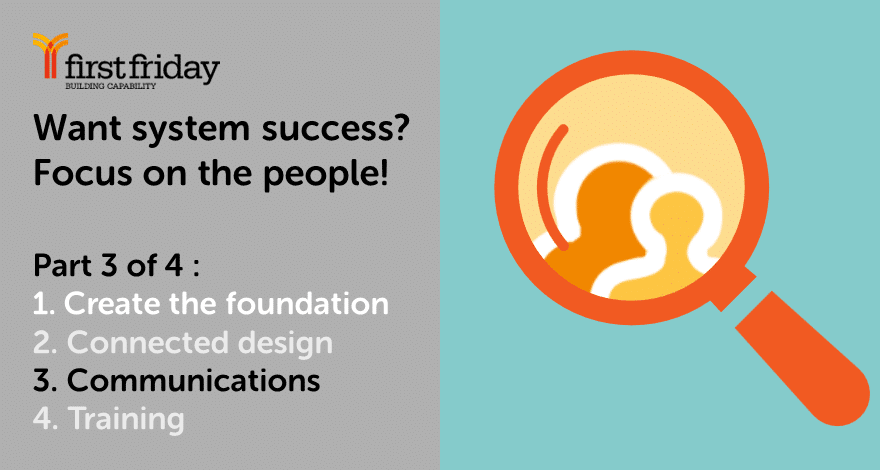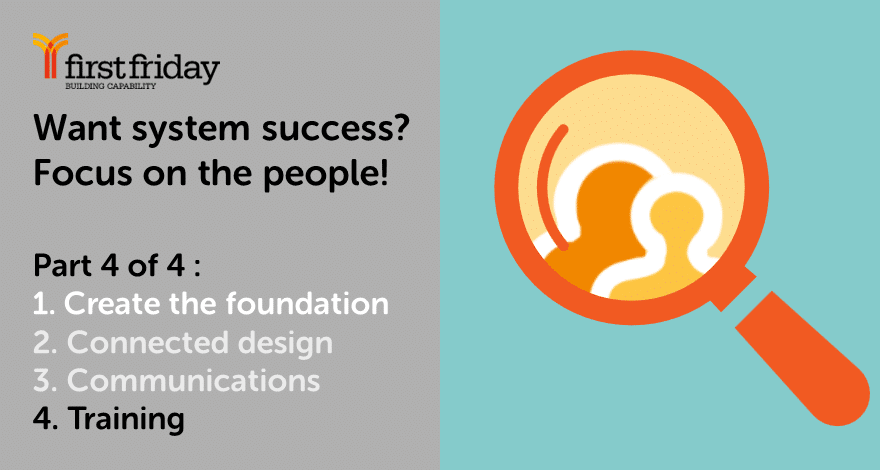In the first 2 posts from this series looking at the key steps to delivering successful change, we have so far discussed:
- Putting people at the heart of change – teams and stakeholders
- Creating and articulating a high-level vision for the change
- Agreeing benefits
- Building capability
- Addressing challenges
- Ordering the design process effectively
- Designing the processes, systems and organisation principles
(If you missed them, part 1 covered foundations for successful change, and part 2 looked at balancing capabilty and design)
In this post, we’re going to look at taking the change from the key stakeholders through to a wider audience through communication.

Delivering engaging change comms
Throughout the change cycle, appropriate communication and engagement is key. This includes everything from one-to-one senior stakeholder interaction through to business-wide broadcast communications.
Critical to the success of this is regular monitoring of where the interested parties are on the change curve – from unaware through to committed – so that messaging and approach can be tailored and delivered by the appropriate person to build engagement and understanding.
For me the key to good comms is understanding the recipient
For me, the key to good comms is understanding the recipient – they will quite naturally want to know what the change means for them and what benefit they get out of it.
Right message, right time, right means
There are a number of mistakes I see commonly:
- Comms which only discuss the benefit to the organisation, not to the individual – This ticks a box but doesn’t engage
- Comms which give way too much detail, much too early – Either things move so you’ve set an expectation you can’t meet, or the programme takes time so people lose faith that it will deliver
- Comms which don’t consider the means of delivery – Often stakeholders will only be influenced by certain types of content delivered in a specific way, or by a specific individual
Ensuring that your key stakeholders were involved in the formulation of the change proposed is really important to the success of communication throughout the programme.
Change leaders need to lead change comms
Whilst external programme team members might write the content and give Frequently Asked Question (FAQ) hints and tips to leaders, it is the leaders themselves who should deliver the message wherever possible. So ensuring you understand what works for these leaders is essential.
It can take time to engage these leaders but clear aims, delivered consistently by leaders, managers and involved teams is so important in enabling teams to feel comfortable and get behind the changes being made.
Identifying when and how to interact with functions indirectly impacted by the change is also important.
Communicating with broader business functions
It’s necessary to have enough clarity of the changes to be able to clearly explain it to other functions, and at the same time remain open to tweaks that make the change palatable whilst remaining effective.
From the point at which you have a high-level design, you should be interacting with these other functions so that they have the opportunity to contribute effectively.
Presenting these interactions as collaborative is critical to their success.
We want these functions to be open, to share their experience and to be open to the changes. You really don’t want to be at the end of detail design and find that there is a key piece of information you are missing or that a fundamental dependency from another function can’t be delivered.
Make it personal
Once you have the leaders of impacted functions on board you can begin to engage with their teams. Communications targeted to the specific audience becomes vital here.
Someone in marketing is not really interested in what the change delivers for finance, they want to know how it will impact them – so all comms to teams need to be thought about from the point of view of the recipients in that particular team.
I need to know what is happening to me and my job before I’m interested in hearing more
For example, as a CEO I may be delighted that the programme will deliver a headcount reduction of 20%, but as a team member, I need to know what is happening to me and my job before I’m interested in hearing more about the change in anything but the broadest terms.
The importance of tone and timing
The timing and tone of communication – not just the content – needs to be thought about carefully and must be interwoven with the programme timings to be effective.
My mantra here is that people infill missing information with their own theories and these theories are rarely either right or positive.
Ensuring that your comms are engaging and appropriate to the audience is fundamental to the success of the programme.
(Successful) communication is a two-way thing
People often fall into telling teams what is happening, but comms that engage aren’t just one way; you’ll need to spend as much time listening as you do sharing if it’s going to be effective.
Doing this well sets the training stage up really well. Not least because you’ll be able to hand your trainers a robust list of Frequently Asked Questions (FAQs) – along with well-thought-through, clearly explained, answers – which will lift the confidence of the delegates massively.
By demonstrating that the change really has really thought through the challenges and processes, their trust in the programme increases dramatically. Which in turn makes it much more likely that you’ll have their buy-in when it comes to upskilling them in order to deliver on the aims of the programme.
But more on that in part 4: landing change through training…





